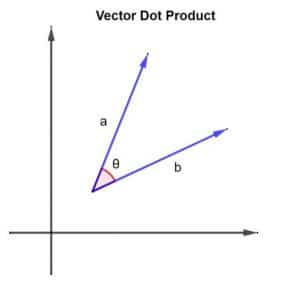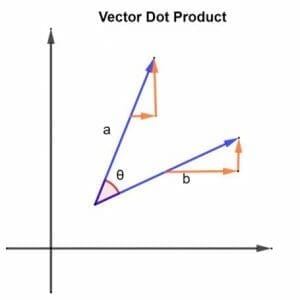- Home
- >
- Vector dot product – Explanation and Examples
JUMP TO TOPIC
Vector Dot Product – Explanation and Examples
 In physics and mathematics, the vector dot product is one of the most fundamental and important concepts. The entire foundation of physical concepts and real-time and space is based on the vector dot product.
In physics and mathematics, the vector dot product is one of the most fundamental and important concepts. The entire foundation of physical concepts and real-time and space is based on the vector dot product.
In simpler terms, the vector dot product is defined as:
“The multiplication of two vectors is defined as the vector dot product.”
In this topic, we will be covering the following concepts:
- What is a dot product?
- How to do the dot product?
- What is the formula for the dot product?
- What are the properties of the dot product?
- Examples
- Practice problems
What Is The Dot Product?
The multiplication of vectors is conducted through dot product such that the two vectors being multiplied produce a scalar product.
The most fundamental concept in mathematics, multiplication, is not only restricted to the real-numbers (defined as scales in mathematical terms). The concept of multiplication can also be implemented in the scope of vector geometry.
This is where the dot product comes in. Vectors are multiplied by using the dot product, and their multiplication is termed as the very famous ‘the dot product.’
Let’s consider 2 vectors, namely a and b. The 2 vectors are arranged in a manner as shown in the figure below:

The 2 vectors, a and b, also form an angle θ between them. Let’s consider the magnitude of vector a to be |a| and the magnitude of vector b to be |b|. This magnitude can also be described as the length of the vectors and a and b. Now that we have our vectors, their dot product can be found by implementing the following:
a.b = |a| x |b| x cosθ
The fun fact about the dot product is that although the multiplication process involves 2 vectors being multiplied with one another, the result they render is actually a scalar, or in non-mathematical terms, a non-vector real number.
The concept of the dot product is widely applied in mathematics and physics. The world of calculations is all about forces and motion, and it is simply inevitable to comprehend the concept without the knowledge of the dot product. Forces and motion are all represented by vectors, and hence the dot product can also be applied to find the resultant or the direction of those vectors.
Example 1
The length of vector a is 13, and the length of vector b is 10. The angle between them is 60𝇇. Find their dot product.
Solution
We know the formula for the dot product, which is:
a.b = |a| x |b| x cosθ
We know that,
Length of a: |a| = 13
Also,
Length of b: |b| = 10
Hence, the dot product is:
a.b = 13 x 10 x cos(60𝇇)
a.b = 130 x cos(60𝇇)
a.b = 65
And the dot product is a scalar number.
Example 2
The magnitude of the force is 200N, whereas the magnitude of the displacement is 30.9. The force makes an angle 45.7𝇇 with the displacement. Find the work done by the dot product.
Solution
We know the formula for the dot product, which is:
a.b = |a| x |b| x cosθ
Let the force be a and displacement be b.
Now,
Length of a: |a| = 200
Also,
Length of b: |b| = 30.9
Hence, the dot product is:
a.b = 200 x 30.9 x cos(45.7𝇇)
a.b = 6180 x cos(45.7𝇇)
a.b = 4316.2
And the dot product is a scalar number.
The dot product applications range from mechanics, motion, the interaction of forces to distance and way-point guidance and location optimization. There are loads of factors that make the dot product unique, such as trigonometric function cosθ instead of other functions. All these factors will be discussed in-depth on this topic.
How To Find The Dot Product
To analyze how to actually find the dot product, let’s consider the 2 vectors, a and b. The vectors a and b also have an angle θ between them. Now, let’s overview the formula again:
a.b = |a| x |b| x cosθ
The dot product, however, can be calculated by following the below steps:
- Multiply the lengths or magnitudes of vectors.
- Multiply the product of magnitudes with the angle.
- The angle is in the form of cosθ.
- The result obtained is a dot product.
Upon looking at the formula, one question bound to arise is any person’s mind is why cosθ? Why not the other trigonometric functions such as sinθ or tanθ?
The answer to this profoundly asked question is given below:
Why cosθ:
The only requirement to implement the dot product is that the 2 vectors which are being multiplied need to be parallel in direction or pointing in the same direction. In mathematical terms, we can conclude this by saying that the 2 vectors need to have an angle of 0𝇇 between them.
Now, if we dive into the trigonometric functions, both sinθ and tanθ produce the result 0. And since the dot product involves multiplication of the vectors’ lengths with the trigonometric function, we cannot use sinθ and tanθ as it will always equate the dot product equation to zero.
But on the other hand, if we analyze the trigonometric function cosθ, it is evident that cosθ produces the result 1. This simplifies our discussion and produces accurate non-zero results of the dot product.
Hence, mathematically concluding, this is the exact reason why we use the below-mentioned formula for calculating the dot product of 2 vectors:
a.b = |a| x |b| x cosθ
Similarly, we can find the angle between the 2 vectors by using the same formula. All it requires is a little rearrangement of the formula to find the angle between the 2 vectors.
The formula can be rearranged in the following manner:
a.b = |a| x |b| x cosθ
(a.b) / ( |a| x |b| ) = cosθ
Or,
θ = cos-1 . (a.b) / ( |a| x |b| )
Let’s conduct some examples to better undersatdn the concept of the angle between the 2 vectors.
Example 3
The dot product of 2 vectors a and b is 57.8. The length of vector a is 45, and the length of vector b is 34. Find the angle between them.
Solution
To find the direction, we will implement the angle formula which is as follows:
θ = cos-1 . (a.b) / ( |a| x |b| )
Now, for the denominator:
|a| x |b| = 45 x 34
|a| x |b| = 1530
Now, let’s apply the formula:
θ = cos-1 . (57.8) / (1530)
θ = cos-1.(0.0377)
θ = 1.533𝇇
Hence, this is the angle between the 2 vectors a and b.
Example 4
The dot product of 2 vectors, having lengths 13 and 10, is 65. Calculate the angle between them.
Solution
To find the direction, we will implement the angle formula which is as follows:
θ = cos-1 . (a.b) / ( |a| x |b| )
Now, for the denominator:
|a| x |b| = 13 x 10
|a| x |b| = 130
Now, let’s apply the formula:
θ = cos-1 . (65) / (130)
θ = cos-1.(0.5)
θ = 60𝇇
Hence, this is the angle between the 2 vectors a and b.
Now, let’s consider another circumstance in which the vectors are not aligned in a parallel manner.
Another Method For Finding The Dot Product
We have comprehensively discussed that any vector which exists in space, whether two-dimensional or three-dimensional, that vector is said to have some respective components directed along the axes of the planes in which the vector exists.
Let’s consider a vector v exists in a two-dimensional plane. This vector v would have 2 components, each one directed along the respective axis. The splitting of this vector into its 2 components can be represented as shown in the figure below:

Both the vectors a and b would have an x-component (along the x-axis) and a y-component (along the y-axis) each. So, we can modify the formula for the dot product to accommodate the concept of vector components in the following manner:
a.b = ax.bx + ay.by
Where ax and bx are the components along the x-axis, and ay and by are the components along the y-axis.
A derivation of this formula is given below:
a.b = |a| x |b| x cosθ
The lengths of the vectors can also be represented in terms of their components:
a.b = (ax+ay) . (bx+by) . cosθ
a.b = (ax.bx.cosθ) + (ay.by.cosθ) + (ax.by.cosθ) + (ay.bx.cosθ)
We have already mentioned that the dot product’s most vital condition is that the 2 vectors need to be parallel with one another so that cosθ can be equal to 1. The vectors directed along the x-axis and the y-axis are parallel to each other, while the remaining are orthogonal.
Hence, we can carry out the derivation as follows:
a.b = (ax.bx.cos0𝇇) + (ay.by.cos0𝇇) + (ax.by.cos90𝇇) + (ay.bx.cos90𝇇)
a.b = ax.bx + ay.by
Which is the dot prodcut defined in terms of the vector components.
These components can also be defined in terms of the mathematical terms i and j. For the components along the x-axis, i is used, and for the components along the y-axis, j is used.
So, the formula can also be written as:
a.b = ai.bi + aj.bj
Let’s solve some examples for better understanding.
Example 5
Find the dot product of the vectors shown in fig (3).
Solution
The following data is evident from the figure:
ax = -6, ay = 8, bx = 5, by = 12
Now, applying the formula:
a.b = ax.bx + ay.by
a.b = (-6).(5) + (8).(12)
a.b = -30 + 96
a.b = 66
Hence, this answer obtained is a scalar quantity.
Example 6
Find the dot product of the following 2 vectors:
a = 5i – 8j ; b = i + 2j
Solution
For this example, we can use the following formula:
a.b = ai.bi + aj.bj
Now, inserting the values in this mentioned formula:
a.b = (5).(1) + (-8).(2)
a.b = 5 – 16
a.b = -11
Hence, this answer obtained is a scalar quantity.
Dot Product In Case Of Three-Dimensions
The vectors don’t need to exist in a two-dimensional plane only. Vectors can also exist in a three-dimensional plane. We have already discussed this in-depth that if a vector exists in a three-dimensional plane, it consists of three components: the x, y, and the z-component.
The concept of the dot product can be extended to three-dimensional vectors as well. In such a case, each vector would consist of three components; x, y, and z. So, to evaluate the dot product of the vectors existing in a three-dimensional plane, we use the following formula:
a.b = ax.bx + ay.by + az.bz
Every formula can be written in mathematical terms as well. Just like we did for the two-dimensional, we would apply the same technique for three-dimensional as well. In mathematical terms, for the components along the x-axis, i can be used, for the components along the y-axis, j can be used, and for the components along the z-axis, k is used.
Hence, by making use of this representation, the formula for the dot product can also be written as follows:
a.b = ai.bi + aj.bj + ak.bk
We can further strengthen the concept of three-dimesnional vectors by conducting the following examples.
Example 7
For the 2 vectors (9,2,7) and (4,8,10), find the dot product.
Solution
As it is evident form the example, the given datas is for vectors in three-dimensiaonl, hence, we apply the following formula:
a.b = ax.bx + ay.by + az.bz
Now, let’s insert these values:
a.b = (9).(4) + (2).(8) + (7).(10)
a.b = 36 + 16 + 70
a.b = 122
The desired dot product obtained in a scalar quantity.
Example 8
Find the dot product of the following 2 vectors:
a = 3j – 7k ; b = 2i + 3j + k
Solution
For this example, we make use of the following formula:
a.b = ai.bi + aj.bj + ak.bk
Now, by inserting the values:
a.b = (0).(2) + (3).(3) + (-7).(1)
a.b = 0 + 9 -7
a.b = 2
The desired dot product obtained in a scalar quantity.
Formulas For The Dot Products
It is quite obvious till now that the dot product cannot be defined by just one formula. There are multiple formulas and multiple expressions through which the dot product can be represented depending on the type of vector presented in the problem statement.
Let’s conclude all those formulas under one heading.
- The general formula for finding the dot product when 2 vectors and their lengths are given is mentioned below:
a.b = |a| x |b| x cosθ
- The angle between the 2 vectors when their dot product is given can be found by using the following formula:
θ = cos-1 . (a.b) / ( |a| x |b| )
- The dot prodcut of 2 vectors in terms of thier components in a two-dimensional plane can be found by using the following formula:
a.b = ax.bx + ay.by
The same formula can also be written as:
a.b = ai.bi + aj.bj
- The dot product of 2 vectors in terms of their components in a three-dimensional plane can be found by using the following formula:
a.b = ax.bx + ay.by + az.bz
The same formula can also be written as:
a.b = ai.bi + aj.bj + ak.bk
Hence these formulas can be used to solve almost any problem concerning vector dot products. Wherever there is a case of vector multiplication that requires a scalar product, the vector dot product is the best plausible solution.
Properties Of The Dot Product
The dot product is one of the most important physics and mathematics concepts, and whole essays can be written on this topic. Being one of the most fundamental concepts in mathematics and physics, it has certain properties associated with it, which further enhance the vector dot product’s uniqueness and validity.
So, a general summary of one of the most iconic concepts in vector geometry, the vector dot product, is given below:
Commutative
The vector dot product is commutative in nature. This means that even by interchanging the elements in the dot product’s equation, the result would remain the same.
This concept can be comprehended as follows:
a.b = b.a
The same concept can also be written as:
|a| x |b| x cosθ = |b| x |a| x cosθ
Scalar Product
One of the unique properties of the dot product is its ability to generate a scalar answer. Although the multiplication process involves 2 vectors, the result they delivered is a scalar quantity.
This concept can be explained through the following same traditional formula:
a.b = |a| x |b| x cosθ
Orthogonal Vectors
The very renowned dot product can also be used to check whether the 2 vectors are orthogonal in nature or not. In simpler terms, we can state that the dot product is a validity check to ensure whether the 2 vectors being multiplied are perpendicular to each other or not.
If the result is 0, then this guarantees that the 2 vectors are actually perpendicular to one another. The following example can strengthen this concept:
Example 9
Find the dot product of the 2 vectors (-12, 16) and (12, 9).
Solution
We will use the following formula to find the dot product:
a.b = ax.bx + ay.by
Implementing the values:
a.b = (-12).(12) + (16).(9)
a.b = -144 + 144
a.b = 0
Since the dot product is 0, hence the 2 vectors are orhtohgonal to eachother.
Distributive
The famous mathematical property, the distributive law, can also be implemented on the dot product. This rule can be implemented on dot products over addition. We can express this property in the following manner:
(b + c) = (a.b) + (a.c)
The result obtained on both sides of the equation would be equal, hence ensuring the dot product over addition in the form of distributive property can be applied.
Practice Problems
- Determine the angle between the vectors (3, -4, -1) and (0, 5, 2).
- Find the dot product of the vectors (6, 2, -1) and (5, -8, 2).
- If the lengths of 2 vectors a and b are 4 and 2 respectively with an angle of 60° between them, find the dot product.
- Determine if the vectors (6, -2, -1) and (2, 5, 2) are orthogonal or not.
- Determine the angle between the vectors (9, 2, 7) and (4, 8, 10).
Answers
- 143°
- 12
- 4
- Yes
- 38.2°
All diagrams are constructed using GeoGebra.
